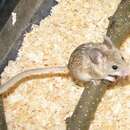en
names in breadcrumbs


The earliest known calomyscid fossils are from upper Pleiocene deposits on the Isle of Rhodes in the Aegean Sea.
Like many other muroid rodents, calomyscids probably have keen senses of smell and touch. Their large, prominant ears indicate that they have a good sense of hearing as well. They are usually silent, but they do sometimes emit high-pitched chirps that may function in communication.
Communication Channels: acoustic
Perception Channels: visual ; tactile ; acoustic ; chemical
Hotson's mouse-like hamster (Calomyscus hotsoni) is listed as endangered by the IUCN. Three other species are listed as lower risk: Afghan mouse-like hamster (Calomyscus mystax), Tsolov's mouse-like hamster (Calomyscus tsolovi), and Urarstk mouse-like hamster (Calomyscus urartensis). Sightings of calomyscids in the wild are rare, and much research is still needed to fully understand the biology of this family of rodents and to assess the status of their populations.
Calomyscidae is a small family of muroid rodents, with 8 species in 1 genus, Calomyscus. The members of this family are known as the mouselike hamsters.
There are no known negative impacts of calomyscids on humans.
Calomyscids have been imported into Europe by zoos in recent years and are sometimes kept as pets by rodent enthusiasts. They have also been used for research in Russian laboratories.
Positive Impacts: pet trade ; research and education
Mouselike hamsters are primary and secondary consumers and they are, in turn, consumed by other animals.
Seeds make up the main portion of the calomyscid diet, but flowers and leaves are eaten as well. In addition, these rodents readily eat animal matter, including insects and sometimes carrion.
Primary Diet: carnivore (Insectivore , Scavenger ); herbivore (Folivore , Granivore ); omnivore
Calomyscids range from western Pakistan throughout Afghanistan and Iran to southwest Syria, and north to southern Turkmenistan.
Biogeographic Regions: palearctic (Native )
These rodents inhabit barren, rocky hills in the dry parts of their range, and hillsides covered with evergreen oaks in the parts of their range that receive monsoons. They live at elevations from 400 to 3500 meters.
Habitat Regions: temperate ; terrestrial
Terrestrial Biomes: desert or dune ; chaparral ; scrub forest
No information is available on the longevity of mouselike hamsters, although it is likely that they live only about 1 to 2 years in the wild.
Calomyscids are small and mouselike in overall appearance, hence the common name of the family. The length of the head and body ranges from 61 to 98 mm, the length of the tail ranges from 72 to 102 mm, and the weight ranges from 15 to 30 grams. There is no apparent sexual dimorphism. The tail is at least as long as the head and body combined, and the ears are large and prominent. The fur is fine and soft; the dorsal surface is pinkish, sandy or gray-brown and the paws and venter are white. The top of the tail is dark and the underside is white, it is covered in thick fur and has a tuft at the tip. There are six mammae. Unlike hamsters in the subfamily Cricetinae, calomyscids lack cheek pouches and sebaceous flank glands.
Other Physical Features: endothermic ; homoiothermic; bilateral symmetry
Sexual Dimorphism: sexes alike
There are no reports of predation on calomyscids. However, they are most likely eaten by predators that consume other rodents, such as owls, snakes, and small carnivorous mammals. Calomyscids are extremely agile and adept at escaping would-be predators. When threatened, they dart into the nearest rock crevice for shelter. If caught in the open, they are capable of running very fast and jumping over 30 cm into the air to evade pursuers.
Known Predators:
No information is available on the mating system of mouselike hamsters.
Calomyscids have a long breeding season that begins in March and may last through December. In captivity, breeding may take place year round. The gestation period is about 21 days. Normally females have two litters per year, with 3 to 7 young per litter.
Key Reproductive Features: iteroparous ; seasonal breeding ; gonochoric/gonochoristic/dioecious (sexes separate); sexual ; fertilization (Internal ); viviparous
Female calomyscids build nests of grasses and other soft materials in which to give birth. The young are altricial, and the eyes open about 13 days after birth. Also at about this time, the young grow their first coat of soft gray fur. Females nurse their offspring for about 17 days, and the young leave their mother 4 to 13 days later. Juveniles become sexually mature at four months of age, but do not reach full adult size and color for another two to four months.
Parental Investment: altricial ; pre-fertilization (Provisioning, Protecting: Female); pre-hatching/birth (Provisioning: Female, Protecting: Female); pre-weaning/fledging (Provisioning: Female, Protecting: Female)